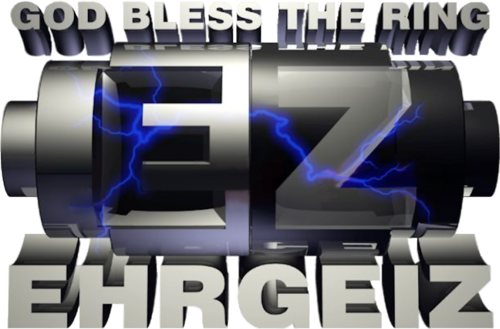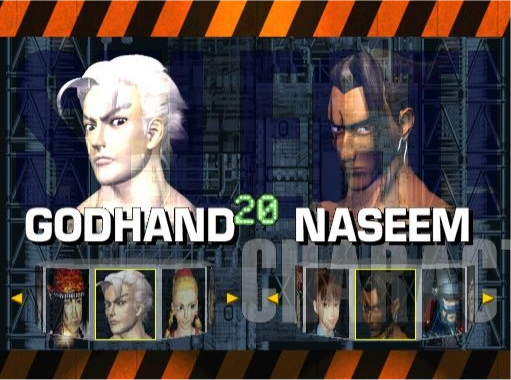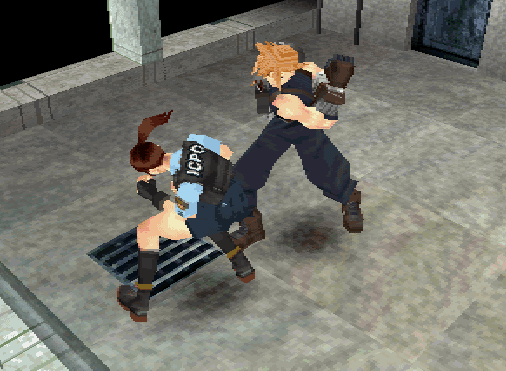Ehrgeiz:
God Bless The Ring

REVIEW:
Ehrgeiz
is a 3D fighting game made with a joint effort from Squaresoft and DreamFactory,
a subdivision of Namco. It was first released in arcades in 1998 and later
ported to the Sony PlayStation in 1999. One of the game's most notable aspects
is the inclusion of many characters from Final Fantasy VII, including:
Cloud Strife, Sephiroth, Tifa Lockheart, Vincent Valentine, Yuffie Kisaragi, and
Zack Fair.
Ehrgeiz offers a very unique 3D fighting game experience, with characters
that can move freely in 3D inside of various closed-in environments. Stages
vary in elevation, with multi-level platforms that characters can jump onto, and
also various interactive elements. Instead of the camera being "fixed"
on the characters like in most fighting games, the camera in Ehrgeiz
zooms in and out with the action. Ehrgeiz's free-roaming 3D engine
borrows concepts from wrestling games and Dream Factory's own Tobal
series, giving the game a unique look and feel among other 3D fighters of
the era.
|

|
|
Godhand... the forgotten
Mishima.
|
Ehrgeiz's 3D gameplay engine gives
players the option of circling their opponent in 3D, or freely running in any
direction. While some "traditional" fighting game players might scoff
at the game's lack of depth, Ehrgeiz's
unorthodox gameplay engine offers a very unique experience to
players able to open their minds to it. Characters have a variety of attack
options at their disposal, including: high
attacks, mid attacks, low attacks, special attacks, projectiles, jumping
attacks, and ground attacks. There's also a targeting
button, a jump button, and combined
button commands for other special move variations. Along with the token priority
attacks, throws, and special moves, fighters can also pick up weapons from the
ground and use them at any time during the fight once they become available.
Graphically, Ehrgeiz is a decent looking PS1 game. Character models and environments are on the blocky
side, but they were considerably better rendered than some other well known
PS1 character models of the time. The game's frame-rate, resolution, and textures
were also fairly impressive when compared to other PS1 titles. The animation of Ehrgeiz
is one of the game's strong points, with many cool-looking attacks and
hard-hitting throws to check out. Right off the bat, Ehrgeiz clearly
takes inspiration from Namco's
TEKKEN series and even
appears to reuse certain assets and animations from past TEKKEN games.
Not only the animations but the character designs themselves subtly but clearly
show Namco's influence.  In retrospect, it would be fair to say that Ehrgeiz was sort of an
under-appreciated "crossover" title at the time - the game itself
being a unique joint effort from DreamFactory and Squaresoft.
In retrospect, it would be fair to say that Ehrgeiz was sort of an
under-appreciated "crossover" title at the time - the game itself
being a unique joint effort from DreamFactory and Squaresoft.
|

|
|
Interesting
3D mechanics that look familiar on PS1.
|
Ehrgeiz
was a halfway decent arcade
fighting game in 1998. It certainly managed to stand out at any arcade that had
it, as it was pretty rare in North America. However, it also felt like the game was missing
something, and couldn't really compete technically with the top competitive arcade fighting
games of the era. Thus, the
later improved PlayStation
version added new characters, tweaked gameplay, new features, and also included an interesting
"RPG style" Quest Mode (comparable to Tobal
No. 1 and Tobal 2).
|

|
|
The
Fighting Game debuts of Cloud and
Sephiroth!
|
Ehrgeiz's Quest Mode was one of the most ambitious and interesting bonus modes seen in a fighting game to date, and featured a
respectable amount of depth. Quest Mode is basically a "Hack and Slash" style action-RPG which begins in a dungeon
in a parallel universe, and later moves to a nearby inn.
The player can explore
the town and enter the dungeon, which contains randomly generated maps, in
search of artifacts and power-ups. It's pretty addicting the first time
through, though it lacks any real storyline. Ehrgeiz also features an
entertaining (but random) Mini Game Mode, including track & field events, as well as
a version of the
board game, Othello. These extra modes added a lot of personality and replayability
to the home version of Ehrgeiz.
|
|

| Page Updated: |
March
31st, 2025 |
| Developer(s): |
Dream
Factory |
| Publisher(s): |
Namco Arcade
Square 
Square Electronic Arts 
Square Enix PSN
|
| Designer(s): |
Seiichi Ishii |
| Platform(s): |
Arcade,
PS1, PSN
|
| Release Date(s): |
Feb.
26th, 1998  Arcade Arcade
Mar. 19th, 1998  Arcade Arcade
Dec. 17th, 1998  PS1 PS1
May 30th, 1999
 PS1 PS1
Feb. 8th, 2000  PS1 PS1
July 9th, 2008
 PSN PSN |
| Characters: |
Godhand,
Yoko Kishibojin, Wolf Girl Jo,
Dasher Inoba, Prince
Doza, Koji Matsuda,
Sasuke,
Lee
Shuwen, Clair,
Han
Dae Han, Django, Cloud
Strife,
Tifa Lockheart,
Vincent Valentine,
Yuffie Kisaragi,
Zack Fair,
Sephiroth |
|
|
|
Featured Video:
|
|
|
| Related Games: |
Tobal No. 1, Tobal
2, TEKKEN
3, TEKKEN 2, Bushido
Blade 2, Soul Blade, Soul
Calibur, Battle Arena Toshinden 3, Bloody
Roar, Guilty Gear X, Mace: The Dark Age, Fighting
Vipers 2, Fighting Layer, Street
Fighter EX2, Power
Stone, Granblue Fantasy Versus |
|

|
|
Gameplay
Engine
|
7.0 / 10
|
|
Story
/ Theme
|
8.0 / 10
|
|
Overall
Graphics
|
8.0 / 10
|
|
Animation
|
8.0 / 10
|
|
Music
/ Sound Effects
|
8.0 / 10
|
|
Innovation
|
9.0 / 10
|
|
Art Direction
|
9.0 / 10
|
|
Customization
|
6.0 / 10
|
|
Options / Extras
|
8.5 / 10
|
|
Intro / Presentation
|
8.5 / 10
|
|
Replayability / Fun
|
7.5 / 10
|
|
"Ouch" Factor
|
8.0 / 10
|
|
Characters
|
8.0 / 10
|
|
BOTTOM LINE
|
8.2
/
10
|
|
Review based on PS1 version
|
|
| Final
Words: |
Ehrgeiz was a very unorthodox yet very interesting fighting game project from Namco & Squaresoft. That said, what a cool collaboration this was for '98 (and very before its time). While the free-roaming gameplay may've not appealed to everyone (least of all traditional FG players), Ehrgeiz was
respectably ambitious and innovative for a console fighting game.
Ehrgeiz's diverse character roster, great art direction, stylish
CG intro,
and entertaining bonus modes made the console version a fighting game package you'd feel proud to own in the late 90's. To not call this game a "rare PS1 gem" would probably mean you didn't own a PS1 (and didn't know what you were missing).
Of course, the fact that Final Fantasy VII characters were playable definitely added hype to the game. For
any sort of FFVII fan, it was epic at the time to see FFVII's
well-known characters in an actual fighting game... even though their movesets and in-game personas came up a bit short.
Either way, Ehrgeiz's roster was attractive and unique. The game's exclusive
character designs aren't
half bad themselves, but some are a bit underdeveloped. In
retrospect, Ehrgeiz was a particularly "fun" and innovative title that stood on its own. It did a lot of things right. Maybe if the game got a sequel, the gameplay could've taken the step forward it needed to stay competitive in the late 90's. By the way, "Ehrgeiz"
means "ambition" in German. Random Fun Fact: I am part German. 
~TFG Webmaster | @Fighters_Gen
|
|
|
|
|
|
|
|
|
|
|
|
|
|
|